Arts Integration
Keep the Arts a Focus in Your Child’s Education
Advantage Arts Academy (AAA) utilizes an array of methods to incorporate arts into the curriculum to support elementary student academic success. AAA’s purpose is to continue to improve student learning and increase choice of learning opportunities for students. The school will focus on engaging instruction that is aligned to the Utah Core Standards. Utilizing all of the elements of Beverley Taylor Sorenson Arts Learning Program (BTSALP) model, AAA teachers will help students meet and exceed student achievement goals by engaging them through arts integration in the core curriculum.
“The arts, it has been said, cannot change the world, but they may change the human beings who might change the world.”
- Maxine Green
By integrating arts into daily learning, schools have seen the following student improvements:
- State Assessment Test Scores
- Higher Attendance Rates
- Increased Retention
- Boosted Self Esteem
“Arts Integration” is defined by the Kennedy Center as an approach to teaching in which students construct and demonstrate understanding through an art form (2016, Arts in Education Research Study). The Kennedy Center research study found students in arts-integrated classrooms are more creative, engaged, and effective at problem solving than their counterparts who are not in arts-integrated classrooms.
The Beverley Taylor Sorenson Arts Learning Program (BTSALP) models focus is to provide arts-integrated instruction to elementary-age kids. The goal is to increase student performance in all subjects and throughout the curriculum. The infrastructure of the program is divided into four art disciplines:
- Visual Arts
- Dance
- Music
- Theater
“I believe arts education in music, theater, dance, and the visual arts is one of the most creative ways we have to find the gold that is buried just beneath the surface. They (children) have an enthusiasm for life a spark of creativity, and vivid imaginations that need training – training that prepares them to become confident young men and women.”
– Richard W. Riley, Former US Secretary of Education
AAA’s commitment to aligning with the Beverley Taylor Sorenson Arts Learning Program (BTSALP) model is reflected in the following goals:
- Define and refine expectations across BTSALP model program implementation areas;
- Develop infrastructure to support the implementation of the BTSALP model;
- Align subject core and arts core to maximize use of the BTSALP model and provide resources for other schools;
- Generate coherence between BTSALP model and other school organization and structures, teaching and learning expectations, reforms/initiatives, and school improvement efforts;
- Develop leadership capacity for arts integration across the school and among stakeholders;
- Ensure and share resources such as time, physical space, materials, curriculum, training and development, and staff; and
- Cultivate support among multiple stakeholders, including the school community, the district, the universities, and the state.
Arts Integration Examples
We incorporate the art disciplines throughout the curriculum in order to engage learners and stretch capacity. Below is a very small sample of a grade-level activity our students have experienced.
Kindergarten
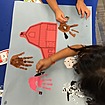

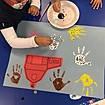
Kindergartners had the opportunity to learn about animals living on a farm and how they act and survive. The class acted out how the animals look and sound with their bodies. Then the class used their hands to create the different animals. The class painted hands onto the paper and then added the extra details needed to make a farm animal.
First Grade

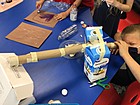

In first grade students learn about inventions and problem solving. The class learned what it means to recycle and to invent something new. Then the class put their minds to the test to create their very own inventions and artworks out of recycled materials that our classes collected. Some inventions students created included a telescope, robot, and bird in its nest.
Second Grade
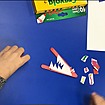
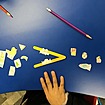

In second grade students learned about the greater than, less than, and equal to symbols. They talked about how they look similar to an alligator's mouth and how the alligator always wants to eat the bigger number. The class then made popsicle stick alligators by adding eyes and teeth, then had fun imagining what an alligator might eat. The class made some silly food like pizza and cupcakes as well as fish and small birds. After students cut out the different alligator food they played a game with the alligators to see what numbers were greater than or less than.
Third Grade
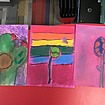
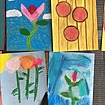
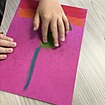
The third grade classes learned that a haiku is a poem including three lines that have a syllable pattern of 5, 7, 5. Students then wrote their own haiku about plants and food. Students researched examples of illustrations and Paul Cezanne's paintings to see what elements and principles of art were used. Then the class made their own illustrations of a haiku using chalk pastels. They really focused on using texture, color, and proportion in the illustrations. The class then recited their haiku's to each other and displayed their interpretation.
Fourth Grade

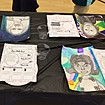
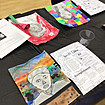
Fourth graders learned about historical figures for black history month. The students had a culminating luncheon to celebrate and share. Students brought their portrait they made and the biography they wrote about the individual they researched. Then each student introduced their historical figure and was able to view each others projects.
Fifth Grade

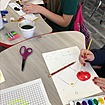
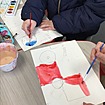
Our fifth grade students created visual representations of a number and the place value of the number. They first reviewed place value and thought about how art can connect with math. Students worked with partners to create a math problem that they could represent visually. The size of their shapes represented different place values. Each partner picked either a circle or square and warm or cool colors. Then they worked together to create an interesting composition to represent the math problem.
Sixth Grade
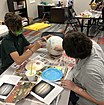


Sixth graders learned about the solar system. Students created the planets out of paper mache. The class tried to make a scaled model as if the Sun's diameter were 150 inches. Students painted the planets and tried to pay close attention to the colors and textures of the planets' surfaces. Students also worked together to create a galaxy background using chalk pastels that will hang behind the planets when they are all complete. The class learned a lot about each planet and the solar system.